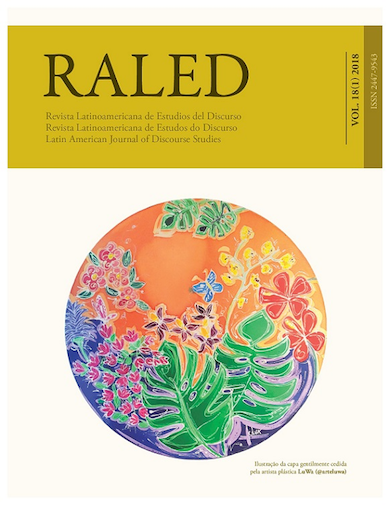Música en resistencia
Construcciones discursivas a través del son jarocho en California
Palabras clave:
música política. discurso oculto. identidad. resistencia. representación.Resumen
El son jarocho es un fenómeno sociocultural originario de Veracruz, México. Entendido como género musical dentro de la globalización, es escuchado, practicado y re-significado en diversos lugares del mundo. A partir de la década de los años 90 del siglo XX, las relaciones entre artistas chicanos y veracruzanos alrededor del son jarocho se han intensificado. El presente trabajo tiene como objetivo general estudiar las estructuras discursivas que se manifiestan en términos de resistencia cultural y política en cuatro grupos chicanos de Los Ángeles, California: Quetzal, Las Cafeteras, Cambalache y Chicano Son. Para ello, se utilizaron algunos preceptos del Análisis Crítico del Discurso (ACD) y se consideraron como fundamentales los conceptos: música política, abordado por Dunaway (1987); identidad, de la obra de Giménez (2005); discurso, de Van Dijk (2000) y Scott (2000); y representación, de Hall (2011). Se presentan los resultados obtenidos a partir del análisis de cuatro canciones.
Descargas
Citas
ARISTEGUI, C. 2013. [Disponible en línea en https://aristeguinoticias.com/0804/mundo/censo-revela-que-en-eu-viven-33-6-millones-de-personas-de-origen-mexicano/]. Censo revela que en EEUU viven 33.6 millones de personas de origen mexicano. [Consulta: 2 de febrero de 2018].
CALSAMIGLIA, H. Y TUSÓN, A. 2007. Las cosas del decir. Manual de análisis del discurso. Barcelona: Ariel.
CARDONA, I. 2011. Fandangos de cruce: la reapropiación del son jarocho como patrimonio cultu-ral. Revista de Literaturas Populares 9, 1: 130-146.
CARDONA, I. Y RINAUDO, C. 2017. Son jarocho entre México y Estados Unidos: definición “afro” de una práctica transnacional. Desacatos: Revista de Antropología Social 53: 20-37.
ASTRO, C. 2013. Una historia de fandango. Los Ángeles, California: Greenham at Infrasonic Sound.
CHICANO SON. 2015. [Disponible en línea en http://chicanoson.com/music/]. El golpe. [Consulta: 5 de marzo de 2015].
CHILTON, P. Y SCHÄFFNER, C. 2000. Discurso y política. En T. Van Dijk (comp.). El discurso como interacción social, pp. 297-329. Barcelona: Gedisa.
DUNAWAY, D. 1987. Music and politics in the United States. Folk Music Journal 5, 3: 268-294.
EZLNY BFZ. 1998. Quetzal. San Francisco, California: Son del barrio.
FIGUEROA, R. 2007. Son jarocho. Guía histórico-musical. México: CONACULTA.
FIGUEROA, R. 2014. El son jarocho en los Estados Unidos de América. Globalizaciones, migraciones e identidades. Xalapa: Universidad Veracruzana.
FRITH, S. 2011. Hacia una estética de la música popular. En F. Cruces (comp.). Las culturas musi-cales. Lecturas en etnomusicología, pp. 413-435. Madrid: Trotta.
GIMÉNEZ, G. 2005. Teoría y análisis de la cultura. México: CONACULTA”“ICOCULT.HALL, S. 2011. Introducción: ¿quién necesita identidad? En S. Hall y P. Du Gay (comps.). Cuestiones de Identidad, pp. 13-39. Buenos Aires: Amorrortu Editores.
HERNÁNDEZ-LEÓN, R. 2013. Cambalache y el intercambio chicano-jarocho. Una historia de fandan-go. Los Ángeles, California: Greenham at InfrasonicSound.
KCET. 2013. [Disponible en línea en http://www.kcet.org/shows/live_at_the_ford/flores-magon/blog-3/chicano-son.html]. Variedades: the ballad of Ricardo Flores Magón. [Consulta: 2 de mayo de 2015].
KRÜGER, S. 2008. Ethnography in the Performing Arts A Student Guide. Liverpool: Palatine.
LAS CAFETERAS. 2012. It’s time. Los Ángeles, California: Bedrock Studios.
LOZA, S. 1993. Barrio Rhythm. Mexicanamerican music in Los Angeles. Illinois: University of Illinois Press.
MACIEL, D. y BUENO, P. 1975. Aztlán. Historia del pueblo chicano (1848/1910). México: Secretaría de Educación Pública.
OGAS, J. 2013. Nombrando Latinoamérica. Revolución y resistencia desde la nueva canción al hip-hop. Musiker 20: 275-297.PÉREZ, H. 1995. En pos del signo. Introducción a la semiótica. Zamora: El Colegio de Michoacán.
SÁNCHEZ-TELLO, G. 2012. Jaraner@: Chicana/o acculturation strategy. Northridge: California State University.
SCOTT, J. 2000. Los dominados y el arte de la resistencia. México: Ediciones Era.
TEWKSBURY, D. 2013. [Disponible en línea en http://www.kcet.org/arts/artbound/counties/los-an-geles/chicano-son-music.html?utm_source=Twitter&utm_medium=Social&utm_campaign=Art-bound]. Chicano/Son. KCET [Consulta: 2 de diciembre de 2014].
VALENZUELA, J. M. 1998. El color de las sombras. Chicanos, identidad y racismo. México: Colegio de la Frontera Norte - Universidad Iberoamericana - Editorial Plaza y Valdés.
VAN DIJK, T. A. 2000. El estudio del discurso. En T. A. Van Dijk (comp.). El discurso como estruc-tura y proceso. Estudios sobre el discurso I. Una introducción multidisciplinaria, pp. 21-65. Barcelona: Gedisa.
VAN DIJK, T. A., TING-TOOMEY, S., SMITHERMAN, G. y TROUTMAN, D. 2000. Discurso, filiación étnica, cultura y racismo. En T. A. Van Dijk (comp.). El discurso como interacción social, pp. 213-262. Barcelona: Gedisa.
Descargas
Publicado
Cómo citar
Número
Sección
Licencia

Esta obra está bajo una licencia internacional Creative Commons Atribución-NoComercial-SinDerivadas 4.0.
Los/as autores/as conservan los derechos de autor/a y garantizan a RALED el derecho de ser la primera publicación del trabajo al igual que licenciado bajo una Creative Commons Attribution License BY-NC-ND 4.0 que permite a otros compartir el trabajo con un reconocimiento de la autoría del trabajo, copiar y redistribuir el material en cualquier medio o formato.
Os/As autores/as conservam os direitos autorais e garantem a RALED o direito de ser a primeira publicação do trabalho licenciado por uma Creative Commons Attribution License BY-NC-ND 4.0 que permite compartilhar o trabalho com reconhecimento de sua autoria e cópia e redistribuição do material em qualquer meio ou formato.




